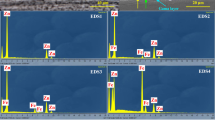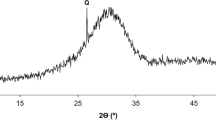Abstract
The combined effect of phosphate ions as corrosion inhibitor and sodium hypochlorite as biocide is studied on aluminum brass in contact with artificial tap water. The interaction between phosphates and hypochlorite was evaluated by electrochemical techniques for films formed between 2 and 192 h and by weight loss tests for immersion times of 90 days. Raman spectroscopy and X-ray photoelectron spectroscopy were used to study the passive layer. When the biocide agent is present, dezincification is the predominant form of localized corrosion after long time exposures. When the inhibitor is present, a nobler pitting potential was found. Electrochemical impedance spectroscopy (EIS) results suggest the development of a compact passive layer, regardless of the presence of the biocide. No localized attack was detected on samples immersed for 90 days at open circuit potential in the presence of phosphates, even when NaClO is present. Weight loss analysis showed inhibition efficiencies higher than 90 % when phosphates and the biocide are present. The oxidative nature of NaClO could favor Zn dissolution and enhance the precipitation of Zn3(PO4)2 layer, producing a more compact surface layer.







Similar content being viewed by others
References
Atlas D, Coombs J, Zajicek OT (1982) The corrosion of copper by chlorinated drinking waters. Water Res 16(5):693–698
Hong PKA, Macauley YY (1998) Corrosion and leaching of copper tubing exposed to chlorinated drinking water. Water Air Soil Pollut 108:457–471
Boulay N, Edwards M (2001) Role of temperature, chlorine and organic matter in copper corrosion by-product release in soft water. Water Res 35(3):683–690
Cong H, Scully JR (2010) Effect of chlorine concentration on natural pitting of copper as fuction of water chemistry. J Electrochem Soc 157(5):C200–C211
Rushing JC, Edwards M (2004) Effect of aluminium solids and chlorine on cold water pitting of copper. Corros Sci 46:3069–3088
Morales J, Fernandez GT, Esparza P, Gonzalez S, Salvarezza RC, Arvia AJ (1995) A comparative study on the passivation and localized corrosion of [α], [β], and [α] + [β] brass in borate buffer solutions containing sodium chloride—I. Electrochemical data. Corros Sci 37(2):211
Rylkina MV, Kuznetsov YI, Kalashnikova MV, Eremina MA (2002) Brass depassivation in neutral chloride media. Prot Met 38:387–393
Valcarce MB, de Sanchez SR, Vazquez M (2005) Localized attack of copper and brass in tap water: the effect of Pseudomonas. Corros Sci 47(3):795–809
Kosec T, Milosev I, Pihlar B (2007) Benzotriazole as an inhibitor of brass corrosion in chloride solution. Appl Surf Sci 253:8863–8873
Código Alimentario Argentino (Ley 18284). Capítulo XII, artículo 982, Bs. As., Argentina
Valcarce MB, Vázquez M (2010) Phosphate ions used as green inhibitor against copper corrosion in tap water. Corros Sci 52:1413–1420
Yohai L, Vázquez M, Valcarce MB (2011) Brass corrosion in tap water distribution systems inhibited by phosphate ions. Corros Sci 53:1130–1136
Yohai L, Schreiner WH, Vázquez M, Valcarce MB (2011) Surface characterization of copper, zinc and brass in contact with tap water inhibited with phosphate ions. Appl Surf Sci 257:10089–10095
Lytle D, Nadagouda MN (2010) A comprehensive investigation of copper pitting corrosion in a drinking water distribution system. Corros Sci 52:1927–1938
Critchley MM, Cromar NJ, McClure NC, Fallowfield HJ (2003) The influence of the chemical composition of drinking water on cuprosolvency by biofilm bacteria. J Appl Microbiol 94:501–507
APHA/AWWA/WEF (1995) Standart methods for examination of water and wastemater, 19th edn. Washington DC, USA
(1996) Guidelines for drinking-water quality, Health criteria and other supporting information, vol 2, 2nd edn. World Health Organization, Geneve
American Society of Testing and Materials, ASTM G61-86 (1993). Philadelphia
Moulder JF, Stickle WF, Sobol PE, Bomben KD (1995) Handbook of X-ray photoelectron spectroscopy. Physical Electronics Inc, Minnesota
Yohai L, Schreiner WH, Vázquez M, Valcarce MB (2013) Phosphate ions as inhibiting agents for copper corrosion in chlorinated tap water. Mater Chem Phys 139:817–824
Valcarce MB, de Sanchez SR, Vazquez M (2006) A comparative analysis of copper and brass surface films in contact with tap water. J Mater Sci 41(7):1999–2007
Palit A, Pehkonen S (2000) Copper corrosion in distribution systems: evaluation of a homogeneous Cu2O film and a natural corrosion scale as corrosion inhibitors. Corros Sci 42:1801–1822
Shim J, Kim J (2004) Copper corrosion in potable water distribution systems: influence of copper products on the corrosion behaviour. Mater Let 58:2002–2006
Aljinovic LJ, Gudic S, Smith M (2000) Inhibition of CuNi10Fe corrosion in seawater by sodium-diethyl-dithiocarbamate: an electrochemical and analytical study. J Appl Electrochem 30:973–979
Zplot for windows (1998) I. Scribner Associates,
Folquer ME, Ribotta SB, Real SG, Gassa LM (2002) Study of copper dissolution and passivation processes by electrochemical impedance spectroscopy. Corrosion 58(3):240–247
Burzynska L (2001) Comparison of the spontaneous and anodic processes during dissolution of brass. Corros Sci 43:1053–1069
Hamilton JC, Farmer JC, Anderson RJ (1986) In situ Raman spectroscopy of Anodic films formed on copper and silver in sodium hydroxide solution. J Electrochem Soc 133(4):739–745
Frost RL (2004) An infrared and Raman spectroscopic study of natural zinc phosphates. Spectrochim Acta A 60:1439–1445
Frost RL, Kloprogge T, Williams PA, Martens W, Johnson TE, Leverett P (2002) Vibrational spectroscopy of the basic copper phosphate minerals: pseudomalachite, ludjibaite and reichenbachite. Spectrochim Acta A 58:2861–2868
Marchebois H, Joiret S, Savalla C, Bernard J, Touzain S (2002) Characterization of zinc-rich powder coatings by EIS and Raman spectroscopy. Surf Coat Technol 157:151–161
Xu W, Daub K, Zhang X, Noel JJ, Shoesmith DW, Wren JC (2009) Oxide formation and conversion on carbon steel in mildly basic solutions. Electrochim Acta 54(24):5727–5738
Feng Y, Siow KS, Teo WK, Tan KL, Hsieh AK (1997) Synergistic effects between sodium tripolyphosphate and zinc sulfate in corrosion inhibition of copper in neutral tap water. Corrosion 53(7):546–555
Milosev I, Strehblow HH (2003) Electrochemical behaviour of Cu-xZn alloys in borate buffer solution at pH 9.2. J Electrochem Soc 150(11):B517–B524
Cano E, López MF, Simancas J, Bastidas JM (2001) X-ray photoelectron spectroscopy study on the chemical composition of copper tarnish products formed at low humidities. J Electrochem Soc 148(1):E26–E30
Ghodselahi T, Vesaghi MA, Shafiekhani A, Baghizadeh A, Lameii M (2008) XPS study of the Cu@Cu2O core-shell nanoparticles. Appl Surf Sci 255:2730–2734
Feng Y, Teo WK, Siow KS, Tan KL, Hsieh AK (1996) The corrosion behaviour of copper in neutral tap water. Part I: corrosion mechanism. Corros Sci 38(3):369–385
Xiao W, Hong S, Tang Z, Seal S, Taylor JS (2007) Effects of blending on surface characteristics of copper corrosion products in drinking water distribution systems. Corros Sci 49:449–468
Biesinger MC, Payne BP, Hart BR, Grosvenor AP, McIntryre S, Lau LWM, Smart RSC (2008) Quantitative chemical state XPS analysis of first row transition metals, oxides and hydroxides. J Phys Conf Ser 100:012025
Pickering HW (1983) Characteristic features of alloy polarization curves. Corros Sci 23(10):1107–1109
Scherebler RS, Gomez CH, Gardiazabal JI (1987) Potentiodynamic behaviour of α brass in 1 M Na2SO4 solution. Corrosion 43(4):243–247
Luna AMC, Marchiano SL, Arvia AJ (1975) Electrochemical formation and cathodic dissolution of a thin cuprous oxide film on copper in alkaline aqueous solution. J Electroanal Chem 59(3):335–338
Wilhelm SM, Tanizawa Y, Liu CY, Hackerman N (1982) A photo-electrochemical investigation of semiconducting oxide films on copper. Corros Scie 22(8):791–805
Ashour EA, Ateya BG (1995) The effect of phosphates on the susceptibility of alfa-brass to stress corrosion cracking in sodium nitrite. Corros Sci 37(3):371–380
Kılınççeker G, Erbil M (2010) The effect of phosphate ions on the electrochemical behaviour of brass in sulphate solutions. Mater Chem Phys 119(1):30–39
Drogowska M, Brossard L, Menard H (1994) Comparative study of copper behaviour in bicarbonate and phosphate aqueous solutions and effect of chloride ions. J Appl Electrochem 24:344–349
Drogowska M, Brossard L, Ménard H (1992) Effects of phosphate ions on copper dissolution and passivation. J Electrochem Soc 139(10):2787–2793
Cherepy N, Shen T, Esposito A, Tillotson T (2005) Characterization of an effective cleaning procedure for aluminum alloys: surface enhanced Raman spectroscopy and zeta potential analysis. J Colloid Interface Sci 282(1):80–86
Acknowledgments
This work has been supported by the University of Mar del Plata (Grant 15/G351), as well as by the National Research Council (CONICET, PIP0661). L. Yohai wishes to thank CONICET, Argentina, for her fellowship.
Author information
Authors and Affiliations
Corresponding author
Rights and permissions
About this article
Cite this article
Yohai, L., Schreiner, W.H., Vázquez, M. et al. Brass corrosion in chlorinated tap water inhibited by phosphate ions. J Solid State Electrochem 19, 1559–1568 (2015). https://doi.org/10.1007/s10008-015-2778-y
Received:
Revised:
Accepted:
Published:
Issue Date:
DOI: https://doi.org/10.1007/s10008-015-2778-y




